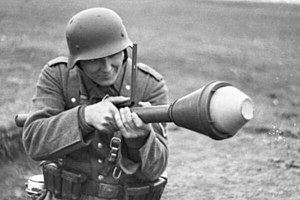
Back بانزر فاوست Arabic Panzerfaust Azerbaijani Панцерфауст Bulgarian Panzerfaust Breton Panzerfaust BS Panzerfaust Catalan Panzerfaust Czech Panzerfaust Danish Panzerfaust German Blendita pugno Esperanto
| Panzerfaust | |
|---|---|
 | |
| Type | Man-portable anti-tank recoilless gun |
| Place of origin | Nazi Germany |
| Service history | |
| In service | 1943–1945 (Germany) |
| Used by | See Users |
| Wars | World War II Greek Civil War |
| Production history | |
| Unit cost | 15–25 Reichsmark |
| Produced | 1942–1945 |
| No. built | 8,254,300 (all variants)[1] |
| Variants | Panzerfaust 30, 60, 100, 150, 250 |
| Specifications (Panzerfaust 60) | |
| Mass | 6.25 kg (13.8 lb) |
| Length | ~1 m (3 ft 3 in) |
| Effective firing range | 60 m (200 ft) |
| Sights | Leaf |
| Filling | Shaped charge |
Detonation mechanism | Impact |
The Panzerfaust (German: [ˈpantsɐˌfaʊst], lit. 'tank fist' or 'armour fist',[2] plural: Panzerfäuste) was a development family of single-shot man-portable anti-tank systems developed by Nazi Germany during World War II. The weapons were the first single-use light anti-tank weapons based on a pre-loaded disposable launch tube, a weapon configuration which is still used today (a modern example being the AT4).
The Panzerfaust-design consisted of a light recoilless launcher tube outfitted with a single pre-loaded high-explosive anti-tank warhead protruding from the muzzle. It was an inexpensive, easy-to-use anti-tank weapon for the common infantry man, being issued as a single unit of ammunition meant to be operated by a single soldier. Firing was done from under the arm at an upward angle as the effective firing range was barely beyond that of hand grenades (30–60 m (98–197 ft) max). After use the launcher was discarded.
Development of the Panzerfaust started in 1942. The initial design was dubbed Faustpatrone (lit. "fist-cartridge") and was smaller than the later designs. Later dubbed Panzerfaust Klein ("tank-fist small"), it entered service in 1943, the larger design being named Panzerfaust Gross ("tank-fist big") and entering service in mid to late 1944. All types were used by Germany until the end of the war, with the design remaining in use in other countries for a number of years after the war.[3][4]
- ^ Panzerfaust and Panzerschreck by Rottman, Gordon L. Shumate, Johnny page 28.
- ^ "Panzerfaust 60". iwm.org.uk. Imperial War Museum. Retrieved 2023-05-07.
The German Panzerfaust (tank or armour-fist)..
- ^ Stallings, Patrick A. "Tank Company Security Operations" (PDF). Major. Archived (PDF) from the original on March 1, 2014.
- ^ Guzmán, Julio S. (April 1942). Las Armas Modernas de Infantería (in Spanish).